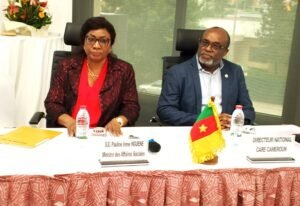 Strategies are underway to boost the education of pupils placed in refugees’ camps in Cameroon.
Strategies are underway to boost the education of pupils placed in refugees’ camps in Cameroon.
As the countdown rose to the 2016- 2017 back to school, strategies to respond to the education of children and adolescents affected by terrorists’ attacks have been put in place by public authorities, local agencies and international organisations in charge of education in Cameroon. Yet, challenges arise daily with regard to the influx of refugees and internal displaced persons notably those from the borders of Cameroon-Nigeria and the Far north region respectively. On the different sites visited, limited infrastructures and human resources have been identified as the main challenges. The Minawao camp for instance, largest site with about 57.000 Nigerian refugees face the current problem of influx. From latest statistics, there are a total of 28.814 schooling children aged from 3 to 17 years. There is lack of classrooms; the ration of pupils, students and teachers per class is higher. Close to 120 pupils per class, only 74 classrooms have been constructed, school kits are insufficient, lack of teachers and the ones present need to be recycled as most of them are not of the profession. A lady interviewed on the site told us that she, as a newly trained teacher was suddenly transferred from Ndop in the North-west region to Minawao in the Far north. For the young teacher, it has been a. shock.
From facts gotten in the regional response plan for 2015-2016, several efforts have been undertaken in order to meet up with the education of children affected .The systems of education in Cameroon and Nigeria differ notably with regard to the language of instruction, as a French-language curriculum is taught in northern Cameroon. This said no major problem was experienced as English speaking schools have been established for Nigerian refugee children. As observed in the Minawao camp, there is high need to create training centers and programmes for youths who have finished with education at the primary and secondary levels and those who have not schooled before. 52% of children aged between 14 to 17 years have not schooled and will need a professional training.
On the other side, the Logone and Chari division of the Far north region still remains under high surveillance. This has been one of those main divisions affected by attacks of Boko Haram due to the geographical situation. The impact of these attacks which crippled economic activities as well as the social behaviours of the populations can still be felt on the spot. Measures have been set up to re-open schools as a total of 63 schools have been shut down, with 49 destructed in the localities of Fotokol, Zina, Makary, Waza, Hile Alifa and Darak. Many are still to be constructed notably in the localities of Goulfey and Blangoua which received many displaced persons.
The situation in the Far north region is almost the same in the East region of Cameroon, with regard to the situation of refugees from the Central African Republic (CAR). Key priorities have been outlined. To provide access to quality education for all affected children and adolescents; Train teachers and support School Management Committees; Strengthen the capacity of Ministry of Education staff in supervision and monitoring; Ensure awareness raising campaigns in communities; Accelerate and target programs for children aged from 9 to 13 and vocational training for adolescents who have never been to school .The main objective of the sector is to ensure provision of quality education to refugees and host populations at pre-school, primary and secondary levels through their integration into Cameroon’s education system. To increase the capacity of local schools in absorbing additional students, additional classrooms and sanitary facilities, with support from the WASH sector, will have to be built. Teaching and learning materials will be provided for teachers and students in all public schools and Temporary Learning Spaces (TLS) in refugee-hosting areas. With regard to secondary education, interventions will include support for tuition and other related costs. At the same time, the education sector will advocate with line ministries, donors and development actors to secure additional funding to address the existing challenges, particularly the recruitment, contracting, training and retention of teachers. The TLS strategy will be pursued in six refugee sites during the 2015- 2016 school year and students will be transferred into the regular system as their capacity gradually increases. Training of trainers on peace education will be provided to teachers with refugee children in their classes. The sector will furthermore support the Ministry of Education in developing appropriate functional literacy and vocational training programs for out of school children (age group of 9 to 17 years old) who can no longer enter the formal education system.
The main objective of the sector is to ensure optimal access to formal education including childhood, primary, secondary, and adult literacy programmes for refugees and children from the host communities. Access to education at all levels will be promoted to ensure that child rights are fully respected. The following activities will be prioritized: pre-school activities for young children; the delivery of literacy programmes, including for adults; advocacy with public education institutions for the deployment of teachers in the camp; capacity building and training for teachers; assistance for children sitting formal exams to pay exam fees. All is therefore set by public authorities and international organisations to save the education of children affected by attacks in Cameroon.
By Elise Kenimbeni





